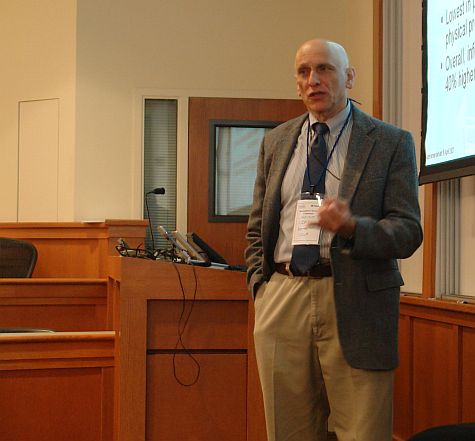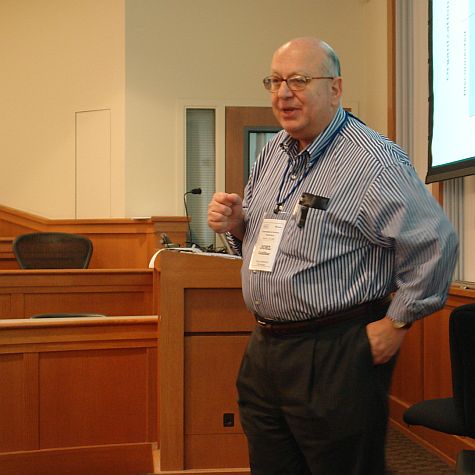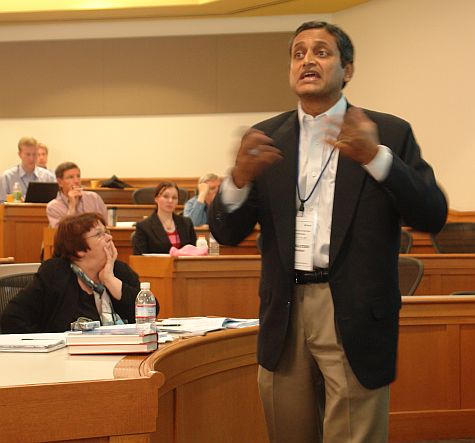This digest was created in real-time during the meeting, based on the speaker's presentation(s) and comments from the audience. The content should not be viewed as an official transcript of the meeting, but only as an interpretation by a single individual. Lapses, grammatical errors, and typing mistakes may not have been corrected. Questions about content should be directed to the originator. The digest has been made available for purposes of scholarship, posted on the Coevolving Innovations web site by David Ing.
Discussant: Kristian Möller, Helsinki School of Economics
Papers:
- “Services Innovation in the 21st Century”, by Goldhar, Braunstein and Berg
- “Information Services in the US Economy”, Apte, Karmarker, and Nath
- “Creating new markets through service innovation”, by Leonard L. Berry, Venkatesh Shankar, Janet Turner Parish, Susan Cadwallander, Thomas Dotzel
- “The Service Myopia: New Recipe for Client-Provider Value Creation”, by Möller, Rajala, and Westerlund
“Information Services in the US Economy”, Uday Apte, Uday Karmarker, and Nath

Dichotomy more helpful that product / services
- India just passed 200 million mobile phones
- Information - material dichotomy
- Machlup 1969, Porat 1977, Apte and Nath 2004
How economy splits across information and material
- Follow Porat's definition, i.e. iPods are part of this economy, as they do nothing but process information
- Study at level of SIC code
Similarly, split in employment across information and material
- Paper to come in a few months
Product versus services, lots of issues in definitions
- To blunt discussion, look at information content of services, going a different direction, and it's a dominant factor
- Nature of transaction and delivery, form, production function
Industry level data from IO, SIC and NAIC codes
- Some work to reconcile
- Differences are mostly lag, particularly in the time it takes to get input-output tables
Double Dichotomy
- x-axis: Delivery form: products, services
- y-axis: End product: material, information
Bucket the data
- Movement to services is well known
- Split between information and non-information going up, has been going on since Machlup
- Will see what happens with 2002 data this summer
- Information economy is a bigger part of the economy, and information services supersector is the biggest piece
- This is what management does, and all of us do
- Problem in information services: services are growing because of low productivity
- What happens when productivity in information services improves? Will look at employment level
- Can look at SIC level, firm level, and job level
- Crossing segments, e.g. Disney is in 3 sectors
Analysis with Korean partners: Choi Rhim Park
- Definitions are not exactly the same in government statistics, but similar trends
Decline in share of traditional manufacturing
- In physical services, there's growth in GNP, but its share is falling
- These are systems-oriented large, e.g. retailing, water, electricity, construction, some of health care (that splits across information and non-information)
- This means in the trend towards services, there's chunk that is not growing
- 1967-1982 decline in computer, then growth in 1992-1997, no explanation yet, only conjectures
- What happens with service industrialization? Good analogy with industrial revolution, call it the services revolution
Not just a shift to services, but also services and information
- Growth in information side
Jobs and wages, done at a different level, Bureau of Labor Statistics, month to month
- Physical services sector has always been a big chunk of the economy, don't know where it's going in the future
- Wholesale trade and retail trade, don't know where it's going
- Splits between information and non-information aren't clear
- Average wage in dollars/year, discrepancy between information and non-information
- There's better job matching, leverage in information
[Questions]
Porat versus information jobs? Explains different
- GNP has secondary information sectors
- Have returns to capital and returns to labour
- If company is highly automated, e.g. web sites, it's not going to show up on labour
- Physical services used to be big for labour; was expecting to see declines in information services sector, but also saw declines in physical information sector
- Goes back to Machlup criticisms: Data means that we go ahead with Porat definition
Skew because hedge fund trader makes more than a trader
- Yes, different level
Medical care costs going up, where does it appear
- Have to estimate splits between information and physical
- Machlup and Porat both come close to 50/50, 49/51
- e.g. nurse: is that information or physical work
- Radiologist is mostly information work
- If a person has to be near a machine, then call that physical work; radiologists from Sweden move to Spain
“Services Innovation in the 21st Century”, by Joel Goldhar, Yale Braunstein and Daniel Berg

Paper is old, when it was written, it wasn't yet 21st century
- IIT, UC Berkeley, RPI
Will try to be a service product
- After yesterday's talk, scrapped the more formal presentation
Think piece, to start some theory building, and be contrarian
- Contrarian is above full professor; then curmudgeon; and then crank, before coming emeritus
Come from business school, am concerned about narrow slicing of the field
- In teaching, need to worry more about convergence of ideas
- May be more helpful to students about what services mean, as compared to factories
- Convergence between human work and machine work
- Strategy, structure, technology
- Innovation, profitability
Game: lists of companies
- Which are services, which are factory "operations"
- A play? Have a script that you follow, have to be in a place where the light hits
Confusion comes from point of view:
- Marketing, or operations, or strategic points of view
- X-axis: Product Type - Production Point of View: tangible, information, experience
- Y-axis: Product Types- Marketing point of View: relationship, durable, convenience
Think about linkages, physical versus organizational.
- X-axis: Physical Links: connected, disconnected
- Y-axis: Organizational Links: disconnected disconnected
| Connected Physical Links | Disconnected Physical Links | |
| Connected Organizational Links | True service | Supply chain or distribution channel |
| Disconnected Organizational Links | An "experience" | "Traditional factory" |
- McDonalds more factory than Burger King
- Barbers that wait for you versus appointments
Services that look like products, and vice-versa, starting with Levitt's productionization of services
- Can't do things until you get economies of scale
- Traditional factory is double decoupled; true service is double coupled
- True service: customer gets involved in design, pricing
What's interesting is the ones that are half-coupled
- Supply chain
- Experience products, not part of it, but have to be there
Digital world to an analog world
- X-axis: Intensity of information of information technology
Ideas on innovation: table of variables
- Innovation and services is easy, not hard
- e.g. new financial services (or are they financial products)
- New financial innovations come up all of the time? Between 30 seconds and a few days
- Few entry barriers, few switching costs
- Easy innovation, but can't make money on this, sustainable, have to do something to make it scalable
[Questions]
Arch slide: how do you map FedEx tracking system?
- It's at the top of the arch
- You're not part of their organization, but more than the post office
- FedEx, you're physically linked, not part of the organization
A pure service that is double connected?
- Having my own masseur on my payroll
- They're part of my system, I control their rewards, you have to physically be there, and they have to be available when I want it
- True services are rare and expensive
- Reliable babysitter had better be a family member
Doesn't scale, babysitters and masseurs
- Grew up in a grocery store, 1949, technology was a telephone
- Customer would phone, would deliver on bicycle or car
- Had a clientele that was captive, because no other store was willing to do this
Any spot on the curve should be equally profitable
- Ford Modelling will provide a digital runway, to scale up a pure service
“Market-creating service innovation”, Leonard L. Berry, Venkatesh Shankar, Janet Turner Parish, Susan Cadwallander, Thomas Dotzel

Venkatesh Shankar, Texas A&M (howdy)
This paper is already published in Sloan Management Review
- Want to use it to create new ideas and extend, dialogue
Why are some new services successful, and others not?
- e.g. FedEx
- Not the first, but the most efficient, became a market leader, and then adjoined other spaces
- Compared to dot-com services that fizzle out overnight
- Why can some create new markets, and sustain them?
- Looked at 100 case examples
Definition: market-creating service innovation
- Exploits an idea
- Fulfills a need
- Perceived by csutomers as new benefit
- Changes customer behaviours
- e.g. Cirque du Soleil
How do MSCIs different from good innovation?
- Some service people use the term product, e.g. banking, hence use "good"
- Labour-intensive, interactive services means that providers get embedded into the innovation
- Inseparable, e.g. Fed Ex
- Co-produced: Cirque du Soleil, involvement of customers, part of the production
- No tangible product
Create two dimensions
- Type of benefit offered:
- Core benefit: gives an underlying reason for a customer to buy, e.g. FedEx ability to transfer a package
- Delivery benefit: convenience of access and experiencing core benefit, e.g. NetFlix, delivery of video as convenient
- Degree of separability:
- Separable: time and place of service production differ from time and place of consumption, e.g. health services, you have to be there
- Non-speparate
4 types of market creating service innovation
| Core benefit | Delivery benefit | |
| Separable | Cell
1: FedEx's Flexible Solutions |
Cell
2: Google's Controllable Convenience |
| Non-separable | Cell
3: Starbuck's Comfortable Gain |
Cell
4: Ball Memorial's Respectful Access |
Cell 1: FedEx was designed to be more reliable and efficient, as other competitors weren't
- Absolutely, positively
- Then they came up with supply chain management, B2B
- Then ground to ground
- Company tried to reduce uncertainty in services
- Other examples in this cell: eBay, CNN (first 24 hour challenge)
Cell 2: Google wasn't first to provide search engines, e.g. Alta Vista
- Google was first for page rank, got a business model based on page search
Cell 3: Starbucks for experience, not just latte, but also CDs
- Emphasis on inseparable, e.g. tables are circular because they're aren't threatening, but are closed
Cell 4: Bell Memorial's emergency room
- How to best deliver service, lessening aggrevation
- Atmosphere like entering a hotel lobby
Findings:
MCI
- Have innovation champion
- Offer superior customer benefit
- Affordable
- Continuous strategic innovation
- Brand differentiation
MSCI
- Scalable business model, e.g. H&R Block has gone on web, converting nonseparable to separable
- Customer experience management, e.g. Cirque du Soleil, former Olympian,
- Continuous operational innovation
Management takeaways
- Make the service easy to use and convenient to access
- Create a trusted brand
- Know you cell
- Create a culture for innovation
[Questions]
Intersection between brand and innovation
- Brand building, companies had to spend
“The Service Myopia? New Recipe for Client-Provider Value Creation”, by Chris Möller, Risto Rajala, and Mika Westerlund
Helsinki School of Economics
Empirical background
- More scientific title: different modes of service innovation
There's a certain amount of hype, that services are the value earners
- Thinking more in terms of hybrids, instead of pure services or pure products
- Emphasis on processes between provider and client may be operational, when we're talking about strategic
Think of basic contingencies influencing the three generic modes of value production, not only within services, but also in value options
| Level of determination | ||||
| High level of determination: order | Low level of determination: chaos | |||
| Value modes | Established
business e.g. Dell, McAfee, Ikea Can specify activities, how to combine lego bricks |
Incremental
servce innovation e.g. Google, TVU Networks Both exploration and exploitation |
Radical
service innovation e.g. Skype, Bluetooth More exploration |
|
| Value creation logic | ||||
| Exchange and relationship structure | ||||
| Value create | ||||
Value modes:
- Not static, movement from radical to incremental to established
Modes of value co-creation
| Service provider's strategy | ||||
| Established service | Incremental service innovation | Radical service innovation | ||
| Client's strategy | Established service | 1. Balanced | 2. Provider-driven | 3, Implausible |
| Incremental service innovation | 4. Client-driven | 5. Balanced | 6. Provider-driven | |
| Radical service innovation | 7. Implausible | 8. Client-driven | 9. Balanced | |
What are the different types of client-provider relationships?
Try to understand the recipe
| Client-driven | ||||
Merging radical and incremental innovations ... mixing them up in the first version
Conclusions:
- Value always rendered by customers, but what resources are used
- Network value production
- Market governance isn't enough, need to understand network and relational governance
[Questions]
Patterns on technology, talent in networks?
- Not enough data, only a few cases so far
- In radical service innovation, can be different drivers, e.g. Bluetooth
- Want to raise the discussion in abstraction
Does the service innovation always start from the radical?
- This is a highly abstract sense-making tool for what's happening in the services world
- Radical service innovations are starting a lot from science

This work is licensed under a Creative Commons Attribution-NonCommercial-ShareAlike 4.0 International License